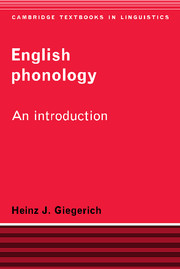Book contents
- Frontmatter
- Contents
- Preface
- 1 Speech sounds and their production
- 2 Towards a sound system for English: consonant phonemes
- 3 Some vowel systems of English
- 4 Phonological features, part 1: the classification of English vowel phonemes
- 5 Phonological features, part 2: the consonant system
- 6 Syllables
- 7 Word stress
- 8 Phonetic representations: the realisations of phonemes
- 9 Phrases, sentences and the phonology of connected speech
- 10 Representations and derivations
- References
- Index
1 - Speech sounds and their production
Published online by Cambridge University Press: 05 June 2012
- Frontmatter
- Contents
- Preface
- 1 Speech sounds and their production
- 2 Towards a sound system for English: consonant phonemes
- 3 Some vowel systems of English
- 4 Phonological features, part 1: the classification of English vowel phonemes
- 5 Phonological features, part 2: the consonant system
- 6 Syllables
- 7 Word stress
- 8 Phonetic representations: the realisations of phonemes
- 9 Phrases, sentences and the phonology of connected speech
- 10 Representations and derivations
- References
- Index
Summary
Organs and processes
Most speech is produced by an air stream that originates in the lungs and is pushed upwards through the trachea (the windpipe) and the oral and nasal cavities. During its passage, the air stream is modified by the various organs of speech. Each such modification has different acoustic effects, which are used for the differentiation of sounds. The production of a speech sound may be divided into four separate but interrelated processes: the initiation of the air stream, normally in the lungs; its phonation in the larynx through the operation of the vocal folds; its direction by the velum into either the oral cavity or the nasal cavity (the oro-nasal process); and finally its articulation, mainly by the tongue, in the oral cavity. We shall deal with each of the four processes in turn. (See figure 1.1.)
The initiation process
The operation of the lungs is familiar through their primary function in the breathing process: contraction of the intercostal muscles and lowering of the diaphragm causes the chest volume to increase and air is sucked into the lungs through the trachea. When the process is reversed, air will escape – again through the trachea. Apart from recurring at regular intervals as breath, this air stream provides the source of energy for speech. In speech, the rate of the air flow is not constant; rather, the air stream pulsates as the result of variation in the activity of the chest muscles.
- Type
- Chapter
- Information
- English PhonologyAn Introduction, pp. 1 - 28Publisher: Cambridge University PressPrint publication year: 1992



